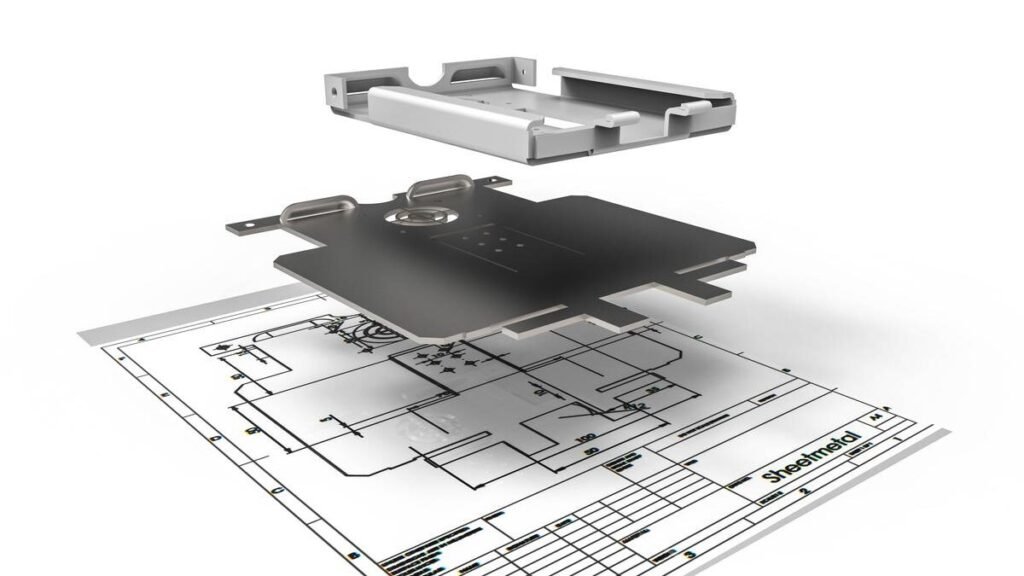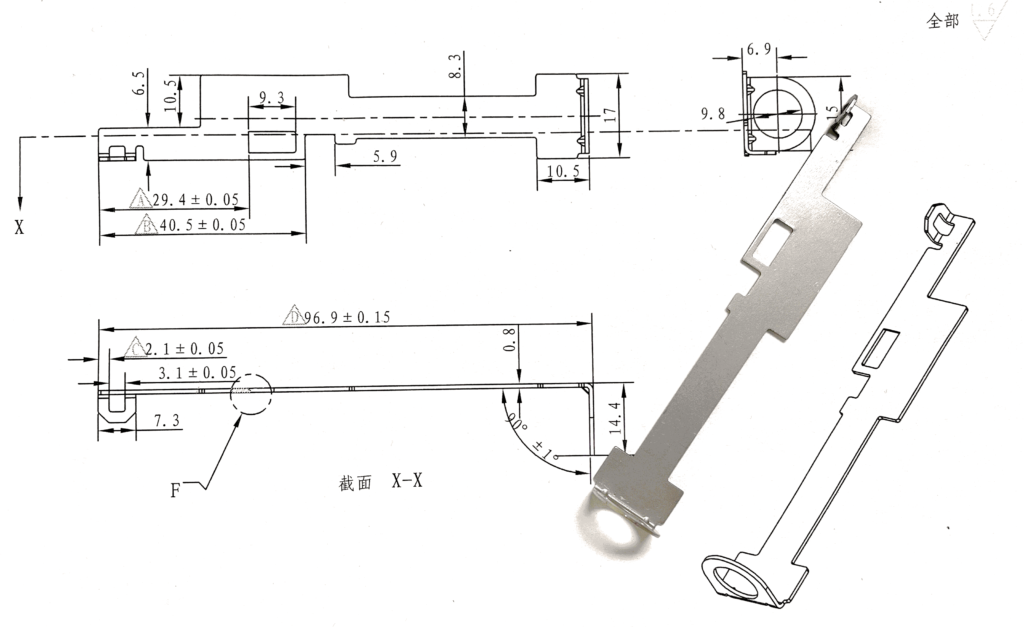Metal stamping is a pivotal process in the manufacturing industry, transforming metal sheets into desired shapes and sizes. But how does one navigate the intricate journey of product development in metal stamping? This guide delves deep into the steps involved, the significance of prototyping, the role of computer-aided design (CAD), and strategies to ensure cost-effectiveness. Did you know that the global metal stamping market is expected to grow significantly in the coming years? Dive in to learn more.
Metal stamping product development involves a series of steps, from conceptualization and design to prototyping and final production. Utilizing tools like CAD can streamline the design process, while prototyping ensures the product meets desired specifications. Ensuring cost-effectiveness is crucial, and this can be achieved through efficient design and production techniques.
Discover the intricacies of metal stamping product development and gain insights to enhance your manufacturing endeavors.

Steps Involved in Metal Stamping Product Development
Metal stamping is a critical manufacturing process that transforms flat metal sheets into specific shapes and components. The development of a metal stamped product involves several intricate steps, ensuring the final product meets the desired specifications and quality standards.
Conceptualization
The first and foremost step in metal stamping product development is conceptualization. This phase involves brainstorming sessions, market research, and understanding the needs of the target audience. It’s essential to define the product’s purpose clearly – what problem will it solve? What are its primary functions? What specifications are required? By answering these questions, manufacturers can set a clear direction for the subsequent stages of development.
Design
Once the concept is clear, the design phase commences. In the realm of metal stamping, Computer-Aided Design (CAD) tools play a pivotal role. These tools allow designers to create detailed, precise, and scalable designs. With CAD, it’s possible to visualize the product in 3D, make necessary adjustments, and ensure that the design is optimized for the stamping process. This phase also involves selecting the right type of metal, determining the thickness, and finalizing other crucial design elements.
Prototyping
After finalizing the design, it’s time to bring the concept to life through prototyping. This step involves creating a physical model of the product. Prototyping serves multiple purposes – it allows manufacturers to test the design, identify potential flaws, and refine the product before mass production. By testing the prototype, it’s possible to ensure that the product meets the desired specifications and functions as intended. Any discrepancies or issues identified during this phase can be rectified, ensuring that the final product is of the highest quality.
Production
With a refined prototype in hand, the production phase begins. This is where the metal stamping process comes into play. The metal sheets are fed into stamping machines, which use dies to transform them into the desired shapes and sizes. The production process involves various techniques, such as punching, bending, embossing, and coining, to achieve the final product. Quality checks are conducted throughout the production phase to ensure consistency and adherence to specifications. Once the production run is complete, the products undergo final inspections before being packaged and shipped to customers.

The Role of Prototyping in Product Development
Prototyping is an indispensable phase in the product development process, acting as a bridge between the conceptual design and the final product. It provides a tangible or visual representation of the product, allowing for testing, refinement, and validation before mass production. Here’s a deeper dive into the significance of prototyping:
1. Importance of Prototyping
- Validating the Design: Prototyping allows manufacturers and designers to validate their design against the initial specifications and requirements. It ensures that the product functions as intended and meets the set criteria.
- Identifying Potential Issues: Through prototyping, any design flaws, functional discrepancies, or potential issues can be identified early on. This early detection saves time, resources, and costs that might be incurred if these issues were discovered after the product has gone into mass production.
2. Types of Prototypes
Prototyping isn’t a one-size-fits-all approach. Depending on the product’s complexity, stage of development, and the objectives of prototyping, different types of prototypes can be employed:
- Basic Mock-ups: These are the simplest form of prototypes, often made from easily available materials. They provide a visual representation of the product but might not have any functional capabilities. Basic mock-ups are useful in the initial stages to visualize the product’s size, shape, and design.
- Functional Prototypes: As the name suggests, these prototypes not only resemble the final product in design but also in functionality. They are made using materials and processes that are close to the final product, allowing for comprehensive testing and validation.
- Digital Prototypes: With advancements in technology, digital prototyping using software tools has become prevalent. These virtual models allow for simulations, testing, and iterations without the need for physical materials.
3. Benefits of Prototyping
The advantages of incorporating prototyping into the product development process are manifold:
- Reducing Production Errors: By identifying and rectifying design flaws during the prototyping phase, the chances of errors during mass production are significantly reduced.
- Enhancing Product Quality: Prototyping ensures that the final product adheres to quality standards, as any discrepancies are addressed beforehand.
- Cost and Time Efficiency: While prototyping might seem like an added expense, it saves costs in the long run by preventing expensive design errors and production halts. It also speeds up the time-to-market by ensuring a smoother production process.
In conclusion, prototyping is not just a step but a crucial strategy in product development, ensuring that the final product is of the highest quality, functionality, and design.

Computer-Aided Design (CAD) in Product Development
Computer-Aided Design, commonly known as CAD, has revolutionized the realm of product development, offering a plethora of advantages that traditional design methods couldn’t match. From intricate machinery components to expansive architectural structures, CAD plays a pivotal role in bringing ideas to life with precision and efficiency. Let’s delve deeper into the world of CAD and its significance in product development:
1. Introduction to CAD:
- What is CAD? CAD is a technology that uses computer systems to assist in the creation, modification, analysis, and optimization of a design. It replaces manual drafting with an automated process, allowing designers to visualize the final product, simulate its functionality, and make necessary adjustments in a virtual environment.
- Why is it essential? CAD is indispensable in modern product development because it offers a detailed and accurate representation of the product, reduces the time taken for design iterations, and allows for easy documentation and collaboration. With CAD, designers can foresee potential issues and rectify them even before a physical prototype is developed.
2. Benefits of Using CAD:
The adoption of CAD in product development is driven by the myriad benefits it offers:
- Precision: CAD allows for exact measurements, ensuring that every element of the design is accurate to the minutest detail. This precision is crucial, especially in industries where even a slight deviation can lead to significant functional discrepancies.
- Efficiency: With CAD, designers can quickly draft, modify, and finalize designs. Automated tools within CAD software can perform repetitive tasks, reducing the time taken and minimizing human errors.
- Ease of Modifications: One of the standout features of CAD is the ease with which designs can be modified. Changes can be made directly on the digital model, and the impact of these changes can be instantly visualized.
3. CAD in Metal Stamping:
In the context of metal stamping, CAD holds particular importance:
- Streamlining the Design Process: CAD allows for the creation of detailed 2D and 3D models of the metal components. These models can be tested in virtual simulations to check their strength, flexibility, and functionality.
- Ensuring Accuracy: In metal stamping, accuracy is paramount. A slight deviation in design can lead to faulty components. CAD ensures that the design is accurate, which, in turn, ensures that the stamped components fit perfectly in their intended applications.
- Integration with Manufacturing: Modern CAD systems can integrate with Computer-Aided Manufacturing (CAM) systems. This integration ensures that the design is seamlessly translated into the manufacturing process, ensuring consistency and quality in the final product.
In summary, CAD is not just a tool but an integral part of modern product development. Its capabilities in design precision, efficiency, and integration make it indispensable, especially in industries like metal stamping where accuracy and quality are of utmost importance.

Ensuring Cost-Effectiveness in Product Development
In the competitive landscape of manufacturing and product development, cost-effectiveness is not just a strategy but a necessity. Balancing the scales of quality and cost while ensuring that the product meets market demands is a challenging yet crucial aspect. Let’s explore the significance, strategies, and challenges of ensuring cost-effectiveness in product development:
1. Importance of Cost-Effectiveness
- Maximizing Profit Margins: At the core of any business is the objective to achieve profitability. Ensuring cost-effectiveness in product development directly impacts the bottom line, allowing businesses to maximize profit margins. By reducing unnecessary expenses and optimizing costs, companies can offer competitive pricing to customers while retaining a healthy profit margin.
2. Strategies for Cost-Effectiveness
Achieving cost-effectiveness requires a combination of strategic planning and tactical execution. Here are some key strategies:
- Efficient Design: Leveraging tools like CAD, as discussed earlier, can lead to efficient and optimized designs. An efficient design reduces wastage, requires fewer materials, and can be produced faster, all contributing to cost savings.
- Bulk Purchasing of Materials: Buying materials in bulk often leads to significant discounts. By forecasting demand and planning production cycles, companies can make bulk purchases, reducing the per-unit cost of materials.
- Optimizing Production Processes: Streamlining production processes, automating repetitive tasks, and minimizing downtime can lead to faster production cycles and reduced costs. Continuous training of the workforce and regular maintenance of machinery also play a role in optimizing production.
3. Challenges in Ensuring Cost-Effectiveness
While the strategies for cost-effectiveness are clear, implementing them comes with its set of challenges:
- Balancing Quality with Cost: One of the primary challenges is ensuring that cost-cutting measures do not compromise the quality of the product. It’s a delicate balance, and businesses need to ensure that any cost-saving strategy does not lead to a sub-par product.
- Navigating Market Fluctuations: The cost of materials, labor, and other inputs can fluctuate based on various market factors. Currency exchange rates, geopolitical events, and supply chain disruptions can lead to unexpected cost escalations. Businesses need to have contingency plans in place to navigate these fluctuations.
- Adapting to Technological Changes: The rapid pace of technological advancements means that businesses need to continuously invest in new tools, machinery, and training. While these investments lead to long-term cost savings, they require significant upfront costs.
In conclusion, ensuring cost-effectiveness in product development is a multifaceted challenge that requires strategic planning, efficient execution, and continuous adaptation. By understanding the importance, implementing the right strategies, and being prepared for challenges, businesses can achieve a balance between cost and quality, leading to sustainable growth.
Conclusion
Metal stamping product development is a meticulous process that requires attention to detail, the right tools, and a focus on cost-effectiveness. By understanding the steps involved and leveraging tools like CAD and prototyping, manufacturers can produce high-quality products that meet market demands. As the industry continues to evolve, staying informed and adapting to new techniques will be key to success. Curious about the latest trends in metal stamping? Let’s explore together.

Frequently Asked Questions (FAQ) on Product Development in Metal Stamping
Q1: What is metal stamping?
A: Metal stamping is a manufacturing process that involves using dies to transform flat metal sheets into specific shapes and components. It’s widely used in various industries, including automotive, electronics, and aerospace.
Q2: Why is prototyping essential in metal stamping product development?
A: Prototyping allows manufacturers to test and validate their designs before mass production. It helps in identifying potential design flaws, ensuring the final product meets the desired specifications, and reducing production errors.
Q3: How does CAD benefit the design process in metal stamping?
A: Computer-Aided Design (CAD) offers precision, efficiency, and ease of modifications. It allows designers to create detailed and accurate designs, visualize the product in 3D, and make necessary adjustments in a virtual environment, ensuring the design is optimized for the stamping process.
Q4: How can businesses ensure cost-effectiveness in metal stamping product development?
A: Businesses can achieve cost-effectiveness by adopting efficient design practices, purchasing materials in bulk, optimizing production processes, and continuously training their workforce. It’s also essential to balance quality with cost and be prepared for market fluctuations.
Q5: What challenges might businesses face in ensuring cost-effectiveness?
A: Some challenges include balancing quality with cost, navigating market fluctuations in material prices, adapting to technological changes, and managing unexpected supply chain disruptions.
Q6: Are there any environmental concerns associated with metal stamping?
A: Yes, like many manufacturing processes, metal stamping can have environmental impacts, including waste generation and energy consumption. However, many businesses are adopting sustainable practices, such as recycling and using energy-efficient machinery, to mitigate these impacts.
Q7: How has technology impacted the metal stamping industry?
A: Technology has brought significant advancements to the metal stamping industry. From CAD tools for precise design to automation in production processes, technology has increased efficiency, reduced errors, and allowed for the production of more complex components.
Q8: What materials are commonly used in metal stamping?
A: Common materials include steel, aluminum, brass, copper, and bronze. The choice of material depends on the product’s intended use, required strength, flexibility, and other specifications.
Q9: How do businesses ensure the quality of stamped products?
A: Quality is ensured through various means, including rigorous design validation, prototyping, continuous monitoring during production, and post-production quality checks and inspections.
Q10: Is metal stamping suitable for producing large quantities of products?
A: Yes, metal stamping is ideal for mass production due to its ability to produce large quantities of components quickly and consistently.



